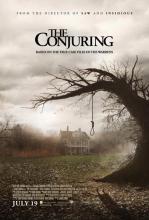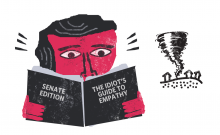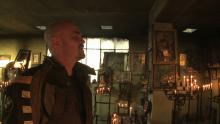Culture

How’s this for an unlikely scenario? One of the characters in Keith Huff’s new crime comedy, Big Lake Big City, is a petty criminal named Stewart who ends up not quite dead after a screwdriver accidently gets embedded in his skull. If the doctors try to remove it, he will die; if they leave it in, he will die. But somehow he isn’t dead yet. For a few days he walks around in a liminal space between life and death, more like a walking corpse than anything else. The sign of his violent demise is there for all to see but he manages to hide it under a Shriner’s cap. A pretty funny sight gag because you have to ignore that fact that the hat is kinda floating off kilter slighter off his head in order not to know something is terribly wrong.
Big Lake Big City is having its world premiere at Lookingglass Theater in Chicago this summer. After seeing the show and interviewing the lead actor Phil Smith for Voices of Peace Talk Radio here at Raven, I couldn’t help but see parallels to another unlikely scenario: a crucified man is resurrected with the marks of his violent death on his body for all to see. I’m pretty sure that Keith Huff did not intend to write a Christian allegory, but the themes of life, death, and resurrection reverberate through the play. Oddly enough, I think Stewart’s story can function as a parable of sorts for understanding the radical shift in the human relationship to death and violence that was made possible by the resurrection. Stay with me, now!

The box office hit The Conjuring has all the requisite features of a standard horror flick: creaky doors, mysterious things that go bump in the night, creepy dolls and a dead witch who seizes the body of an unsuspecting mother.
It also has an unexpected background character for a horror film: God.
Filmmaker brothers Chad and Carey Hayes say their film isn’t your typical “Christian” movie fare, but it nonetheless carries a strong religious message that can appeal to faith-minded audiences.

At the 2012 Wild Goose, for an afternoon set at a tent tucked away on the backwoods of the festival site, a young North Carolina band blew minds and won fans. More than just a band — more like a multicolored movement of sonic jubilee — David Wimbish and the Collection carry the celebratory consciousness, lyrical significance, and live energy that have made bands like Mumford & Sons or Edward Sharpe & the Magnetic Zeros the darlings of the current folk-pop moment.
In August 2013, the Collection will open this year’s festival on the main stage with a Thursday night set sure to thrill us. Then, they will support Phil Madeira’s Friday night set. In the meantime, the Collection are furiously raising funds on Kickstarter for their next album, a surprisingly hopeful take on death called Ares Moriendi. I recently caught up with David Wimbish and convinced him to take a break from writing, recording, fundraising, and preparing for Wild Goose to answer a few questions.

Human beings seem to come with certain built-in spiritual inclinations, and gratitude is chief among them.
Parents and teachers think we have to be taught to say thank you, but maybe it just comes naturally. Gratitude is both accessible and enlivening.
Accessible because it’s as easy as paying attention to that which we might otherwise take for granted.
With gratitude, when our lover holds our hand for the umpteenth time it feels like it’s the first time and we’re grateful for them all over again. Or when we sit down to a plate of something humble and home-cooked it suddenly transports us to all those other meals in all those other places where we felt loved, accepted, and welcomed.

My wife and I are attending our denomination's national assembly in Orlando this week. Last night, we went to a retirement party for one of her mentors. As a group of ministers tends to do, they concluded by gathering around, laying their hands on, and offering him a prayer of blessing. Then the group spontaneously broke out into a round of song that went on for a few minutes. It was both beautiful and touching.
The wait staff, however, wasn’t quite sure how to take it.
"Wow," one bartender said," that's amazing. You guys can all really sing."
Amy just smiled.
“That's church," she said.
Simple Truths
The Live Simply series, a set of four booklets based on the values of St. Francis of Assisi, is packed with practical, portable advice about ethical eating, holistic health, creation care, and sensible shopping. Ideal for anyone seeking a life of simplicity and satisfaction in a world of consumption. Franciscan Media
Lost and Found?
A decomposing body is found in the Sonoran Desert, with a tattoo, “Dayani Cristal.” The documentary Who is Dayani Cristal? shows the efforts to find out who this mysterious migrant was and the journey he likely followed. A haunting look at the people affected by the politics of immigration. www.whoisdayanicristal.com

This week an online ad informed me that Monsters University has finished first at the box office for two weeks running. I’m convicted by the statistic; I saw it somewhere between Northfield, Minn., and the Twin Cities on the “Largest Movie Screen in Minnesota” last week while visiting my brother. But it struck me that the movie presents – probably quite by accident – an opportunity to talk about a deep moral reality. So what follows will only begin obliquely by talking about cute monsters. And it will contain (mostly minor) spoilers. You’ve been warned.

Oddly enough, whenever I think about eternal life, Animal Collective come to mind.
That might — well, almost certainly will — need some clarification because, as many Christians might be quick to point out, shouldn’t Jesus be the first person that comes to mind, or maybe living on some clouds in a golden city or something?
Yes and no. What comes to mind when I think about eternal life is painted by Frederick Buechner’s entry on the subject in his book Wishful Thinking, which I studied for a class in college. Buechner takes religious terms and eloquently and poetically explores what they might mean.

NOTHING MOVES ME more than a heartfelt tweet. Seriously. Don’t think I’m making fun here. I understand that the Twitter universe (“Twitterverse”? “World o’ Twits”?) is the current preferred method for connecting with the most people in the shortest amount of time. It’s certainly preferable to my generation’s method of communicating, which was to spray-paint the sides of barns.
But if the inspirational tweet is from a member of Congress—taking time away from doing the nation’s business in the most powerful city in the world, depending on where the Koch brothers are living at the time—I can get really choked up.
“My thoughts and prayers are with those in Oklahoma affected by the tragic tornado outbreak.”
Oozing with empathy and originality, this tweet was sent out by Oklahoma Sen. Tom Coburn a few hours after the extreme weather event in May that ravaged the town of Moore. What the tweet did not include—and his office quickly added, lest survivors searching through the rubble for loved ones got the wrong impression—was that the senator would not support federal relief funding unless it was offset elsewhere. If it’s not in the budget, according to Coburn’s long-standing philosophy, it’s not happening.
But let’s be fair: With a tweet you only get 140 characters, so in addition to the words “thoughts” and “prayers,” there’s barely enough room left over to express the important concepts of “freedom,” “liberty,” and “bootstraps,” three concepts people just love to think about when they’re crawling from under what used to be their house. Coburn’s point seems to be that when you’re covered with sheetrock, torn family photographs, and spray-painted sides of barns, the last thing you want is some government bureaucrat arriving with a meddlesome helping hand.

Conversations in Transition is a veritable graduate course in what South Africans call ubuntu, or good neighborliness.
Charles Villa-Vicencio and Mills Soko present 23 narratives of both well-known and unsung heroes of the anti-apartheid struggle. These narratives are filled with instructive words of wisdom for seekers of peace with justice in countries emerging from post-tyranny chaos and in long-established democracies alike. Historians and activists will find hope in the stories of South Africa’s courageous, diverse citizens, as well as prophetic insights and warnings as the subjects address post-apartheid violence and oppression in a country still on the edge.
My own experiences lead me to an unqualified endorsement of this invaluable compendium. Over several decades I have pondered repeatedly two particular conversations, one with a Jew in Israel and the other with a Muslim from Cape Town.
An effort was made to introduce the Truth and Reconciliation Commission (TRC) process into the Israel-Palestine conflict. At the end of an evening with South African officials and members of the Israeli and Palestinian communities, the director of a Jewish study center in West Jerusalem, Benjamin Pogrund, shared a revealing comment. He said, “TRC will never work here because Israelis do not have the theological and philosophical understanding of forgiveness and reconciliation that Muslims, Christians, and Jews shared in South Africa in order to bring unity and liberation without major conflict.”
WHEN CECIL WILLIAMS was 8 years old, he imagined murdering a police officer. It’s a jarring way for an influential minister to begin a memoir about radical hope and perseverance. But in a short lifetime of intense oppression, Williams had already internalized heartbreaking lessons of systemic injustice and the righteously violent tendencies that can follow. The budding young leader already nicknamed “Rev” and wise beyond his years also knew that if he could imagine brutality, he could envision a transformed society.
“Imagination is one of the most penetrating and incendiary forces I’ve ever experienced,” he writes in Beyond the Possible: 50 Years of Creating Radical Change at a Community Called Glide, co-authored with his wife and longtime collaborator, Janice Mirikitani. Building on their shared vision over a remarkable half-century, they lead what might be the most exuberant congregation in America. Glide Memorial United Methodist Church and the Glide Foundation are inextricable, legendary San Francisco institutions, the latter one of the city’s largest social service providers and the real-life shelter featured in the 2006 biopic The Pursuit of Happyness.
Writer Dave Eggers sums up Glide in the book’s introduction with a simple but uncomfortable truth: There are very few places in society where someone is not left out. Houses of worship are supposed to make a dream of inclusivity possible, but even the most inspiring visionaries live and lead imperfectly. Eggers proposes that because of the unconditional love necessary for a lasting marriage between two seemingly incompatible leaders—Williams, a black Texas minister with a solid upbringing, and Mirikitani, an agnostic Japanese-American poet from a broken, abusive home—Glide is one of the few radically accepting places where true unconditional love is practiced like the most dogmatic of faiths.
FOR ANYONE who’s sick of explaining that not all evangelicals are flag-waving, Quran-burning, gay-hating, science-skeptic, anti-abortion ralliers, The Evangelicals You Don’t Know: Introducing the Next Generation of Christians provides a boost of encouragement. Written by frequent USA Todaycontributor Tom Krattenmaker, this who’s who of “new-paradigm evangelicals” explains how a growing movement of Jesus-followers are “pulling American evangelicalism out of its late 20th-century rut and turning it into the jaw-dropping, life-changing, world-altering force they believe it ought to be.”
Unlike their predecessors, these new evangelicals are characterized by a willingness to collaborate with members of other religions and no religion for the common good, warm acceptance of LGBTQ folks, a rejection of the dualistic pro-life vs. pro-choice debate, and a desire to participate in mainstream culture rather than wage war against it. All this “while lessening their devotion to Jesus by not a single jot or tittle.”
Admittedly, the book’s cover photo doesn’t quite do justice to Krattenmaker’s observations. Featuring young worshipers in a dark sanctuary with hands uplifted and eyes closed, each apparently lost in a private moment of four-chord progression praise, the cover looks more like a Hillsong worship concert circa 1998 than cutting-edge 2013 evangelicals. (If you’re unfamiliar with the four-chord progression, Google “how to write a worship song in five minutes or less.” You’re welcome.)
THE EXPERIMENTAL psychologist Steven Pinker writes that what we think we have seen will shape what we expect to occur. It doesn’t make the news when people die peacefully in their sleep, or make love, or go for a walk in the countryside, but these things happen far more often—are much more the substance of life—than the acts of terror that preoccupy the media. It was horrifying when a British soldier was killed on an English street in May. But given the ensuing ethnic tension and communal judgment, it might have been useful, not merely accurate, to report that on the same day, almost 3 million British Muslims didn’t kill anyone. Because violence is a pre-emptive act (I kill you because you might kill me), when we keep telling the story that the threat of massive violence is ever-present, we will behave more violently.
According to Richard Rohr, the best criticism of the bad is the practice of the better. So perhaps attention to beauty is the best alternative to our cultural obsession with blood. For me, cinema can do this better than any other art form, and is uniquely capable of transporting the imagination. Recently I’ve traveled to the minds of retired Israeli security service leaders agonizing over their achievements and failures in The Gatekeepers, gone to Louisiana for a trip around the soul of a man trying to redeem himself in Mud, empathized with the tragic story of a man making bad choices to get into a better state in The Place Beyond the Pines, wondered at the creative process and bathed in the French countryside in Renoir, been reminded of and elevated into an imagining of love and its challenges in To the Wonder, and been provoked in Room 237 to consider whether or not Stanley Kubrick intended The Shining to be a lament for the genocide that built America.

IN THE PAST 150 years, the songs historically known as “Negro spirituals” have worn many costumes. They emerged, of course, from the Deep South during the days of slavery, when songs such as “Every Time I Feel the Spirit” or “Wade in the Water” were first sung by anonymous psalmists wielding hoes or pulling cotton sacks. Since that time they’ve been dressed in the style of the European art song, sung as grand opera, or even faithfully mimicked by well-meaning white folk singers.
The spirituals entered the mainstream of American culture through the performances of the Fisk Jubilee Singers from Fisk University in Nashville who, fresh out of slavery themselves, toured the North in the 1870s. In the 1950s and ’60s, the old standards were resurrected, and slightly rewritten, as marching songs for the African-American freedom movement and then echoed across the world as anthems for human rights from South Africa to Northern Ireland to Eastern Europe.
After all that, the spirituals can probably even survive being remade into “smooth jazz,” which is more or less what happens to them on Bobby McFerrin’s new album Spirityouall. Readers of a certain age might remember McFerrin as the guy who, in 1988, conquered the known pop music universe with an airheaded ditty called “Don’t Worry, Be Happy.” The tune was so infectious that it should have had a warning label from the Centers for Disease Control, but instead it dominated radio, won some Grammys, and, to McFerrin’s eternal horror, was used as theme music by the George H.W. Bush presidential campaign.

UNTIL RECENTLY, a company in New York City offered “a ride through a real New York City ‘ghetto’”—a $45 bus tour of the Bronx, reportedly patronized mainly by European and Australian tourists. One news report described the tour guide sharing lurid stories of crime and arson from the ’70s and ’80s, making insensitive comments about everything from local architectural landmarks to people waiting in line at a food pantry, and warning about the “pickpockets” in wait in a certain park. After an outcry from residents and officials, angry that the place they call home would be reduced to out-of-touch stereotypes, the tour company shut down in May.
That someone would even think of fleecing misguided tourists this way hints at the complicated, sometimes contradictory, role that cities play in our culture: In our collective imagination they represent both civilization’s pinnacle (arts, style, technology, intellectualism, innovation, industry, finance) and depravity’s depths (crime, corruption, exploitation, decadence, filth). For much of the 20th century, many people of means fled cities for the pastoral promise of the suburbs, while many a farm girl or boy dreamed of escaping to a city and tasting the bustle and thrill: “Until I saw your city lights, honey I was blind.”
And yet cities are not only symbols, but real and intricate places. Whether booming or busting, they shape and are shaped by the people in them. Both the built structures and the people of a city have stories to tell. But a fleeting tour-bus view with distorted narration can lead us down an alley with no exit.
Here are some different takes on the bright lights of the big city.

Early morning
before he unlocks the church gate
the rector kneels before
the gridiron fence surrounding the Cathedral,
not in prayer
but to collect empty wine bottles,
snack bags, and used condoms.
After shoving them into a bag
he turns the latch key and enters the churchyard
shutting it behind him.
The hollow, thunderous deadbolt
echoes through trees like the voices of
ancient saints.

Superman has always had a bit of a messiah complex, born as a modern-day Moses in the imagination of two Jewish guys during the Depression and over the years developing and amplifying his Christlike characteristics.
So it made sense that Warner Bros. Pictures spared no effort in using the Jesus connection to attract the increasingly important Christian audience to see the latest film in the Superman franchise, Man of Steel.
The studio hired a leading faith-based marketing agency, Grace Hill Media, to hold special screenings for pastors, and it developed an extensive website of Christian-themed resources — including specially-edited trailers for use in churches and Man of Steel sermon notes.

Go Here to read the second in this series, Competing for the Greater Good
Peru is a land of extremes, especially for a motorcycle pilgrimage. Our journey from Lima to the orphanage in Moquegua took us through some of the most severe riding conditions imaginable. Storms of Peru, the second segment in the Neale Bayly Rides series, provided a glimpse into the challenges we faced, as Peru would not give up her beauty easily.
Our ride began in the congested, chaotic streets of Lima — a thriving metropolis of 16 million people — where an aggressive riding posture is your only chance for survival. It’s not that the Peruvians are bad drivers; it’s just that traffic laws don’t seem to be a concern for any of them. Riding through the boiling cauldron of cars felt like a massive vehicular free-for-all. Lima provided a baptism by fire for our adventure and, exciting though it was, we were glad to leave the haphazard traffic behind us.
We rode south toward the beautiful but haunting desert of Ica. The life-smothering heat and blowing sands sweep across the land and stop abruptly at the Pacific Ocean. Riding through the rugged terrain of crushed rock, sugar sand, and loose gravel was even more challenging than it appeared on television. I was glad the production team didn’t show everything. I bit the dust more times than I care to admit.
The country is amazingly beautiful, as are the people. There's a crazy juxtaposition of things you have to see to believe — poverty mixed with joy, beauty and brokenness in the very same face, a fierce gratitude in the meanest of circumstances.

“Listen to the words,” the young woman behind me stage-whispered to her chatty date. “Are you listening?”
He wasn’t. But I was and so was most of the rapt, standing-room-only crowd that crammed the Greek Theatre at UC Berkeley for the second of three sold-out Mumford & Sons concerts late last month.
This is what I had come for — not just a concert, but a shared experience with a congregation of strangers (and a few friends).